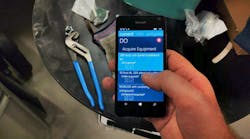The fear never subsides. Daily, manufacturing managers walk through their plant, see valued workers with years of experience and dread the day when those workers will walk out the door.
Not only are these valued team members leaving with their experience, but often there are no workers with the skills necessary to step into these large shoes.
It’s a huge skills gap, especially in blue-collar positions.
But what if there was a different approach to solving this skills gap?
One company, contextere, believes that “all people are skilled but are simply not presented with the right information and technology to apply those skills.”
Gabe Batstone, CEO of contextere, founded his company to employ technology to provide those skills. Based on his technology experience in a number of sectors, including aerospace, his vision was to bring all of the data culled from AI, directly to the workers on the line.
As he explains it: “Warm hands still touch cold steel and the information on how to be safe, and productive is just not reaching these workers. These workers have been left behind when it comes to using the data we are collecting and these are the people who are making our trains run and our planes fly.”
Batstone says this isn’t a difficult problem to solve since we “have the technology, big data, and AI to contextualize the information for blue-collar works and make it consumable.”
Having the correction information and training can address areas where improvement is greatly needed. He cites some statistics:
- On the safety side, there is one incident per day at industrial companies.
- On productivity, over 50% of an industrial worker’s day is spent on unproductive activities such as: sifting through data, searching for equipment, and waiting for colleagues.
- On quality, 25% of the time when an industrial employee attempts to install, repair, or maintain complex equipment they make an error.
Providing data through IIoT, machine learning, AR, and delivering them through wearable devices directly to employees in the plant can resolve those issues.
It also has the benefit of fast-tracking learning. With 50 to 75% of field staff retiring, Batstone points out that the industry really doesn’t have the time to train the new workforce in the old ways. “Imagine on the first day of work, you have at your disposable, through a wearable, all of the knowledge of a seasoned employee, in your pocket 24/7.”
And when it comes to dealing with machinery, this technology will allow a maintenance employee to have a “conversation” with the machine.
These innovations play right into the large issue of worker ability, says Batstone. People can now find the time to do the more interesting, challenging work of problem-solving. “People can get paid for what’s between their ears,” says Batstone.
The company has been working on this product and is in the pilot stage. It will start in the aerospace and defense industry but seems a future market in the area of smart buildings.
Looking ahead the company says that they are solving an important problem by “making sense of the overwhelming amount of data and information generated from smart machines and enterprise analytics to help close the gap in skilled workers.”











